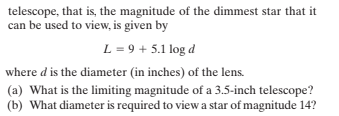48. Limiting Magnitude of a Telescope A telescope is limited in its usefulness by the brightness of the star that it is aimed at and by the diameter of its lens. One measure of a star's brightness is its magnitude; the dimmer the star, the larger its magnitude. A formula for the limiting magnitude L of a telescope, that is, the magnitude of the dimmest star that it can be used to view, is given by L = 9 + 5.1 log d where d is the diameter (in inches) of the lens. (a) What is the limiting magnitude of a 3.5-inch telescope? (b) What diameter is required to view a star of magnitude 14?
48. Limiting Magnitude of a Telescope A telescope is limited in its usefulness by the brightness of the star that it is aimed at and by the diameter of its lens. One measure of a star's brightness is its magnitude; the dimmer the star, the larger its magnitude. A formula for the limiting magnitude L of a telescope, that is, the magnitude of the dimmest star that it can be used to view, is given by L = 9 + 5.1 log d where d is the diameter (in inches) of the lens. (a) What is the limiting magnitude of a 3.5-inch telescope? (b) What diameter is required to view a star of magnitude 14?
College Algebra
7th Edition
ISBN:9781305115545
Author:James Stewart, Lothar Redlin, Saleem Watson
Publisher:James Stewart, Lothar Redlin, Saleem Watson
Chapter4: Exponential And Logarithmic Functions
Section4.7: Logarithmic Scales
Problem 10E: Earthquake magnitude and intensity (a) Find the magnitude of an earthquake that has an intensity...
Related questions
Question

Transcribed Image Text:48. Limiting Magnitude of a Telescope A telescope is limited
in its usefulness by the brightness of the star that it is aimed
at and by the diameter of its lens. One measure of a star's
brightness is its magnitude; the dimmer the star, the larger
its magnitude. A formula for the limiting magnitude L of a

Transcribed Image Text:telescope, that is, the magnitude of the dimmest star that it
can be used to view, is given by
L = 9 + 5.1 log d
where d is the diameter (in inches) of the lens.
(a) What is the limiting magnitude of a 3.5-inch telescope?
(b) What diameter is required to view a star of magnitude 14?
Expert Solution
This question has been solved!
Explore an expertly crafted, step-by-step solution for a thorough understanding of key concepts.
This is a popular solution!
Trending now
This is a popular solution!
Step by step
Solved in 3 steps

Recommended textbooks for you

College Algebra
Algebra
ISBN:
9781305115545
Author:
James Stewart, Lothar Redlin, Saleem Watson
Publisher:
Cengage Learning

Glencoe Algebra 1, Student Edition, 9780079039897…
Algebra
ISBN:
9780079039897
Author:
Carter
Publisher:
McGraw Hill

Algebra and Trigonometry (MindTap Course List)
Algebra
ISBN:
9781305071742
Author:
James Stewart, Lothar Redlin, Saleem Watson
Publisher:
Cengage Learning

College Algebra
Algebra
ISBN:
9781305115545
Author:
James Stewart, Lothar Redlin, Saleem Watson
Publisher:
Cengage Learning

Glencoe Algebra 1, Student Edition, 9780079039897…
Algebra
ISBN:
9780079039897
Author:
Carter
Publisher:
McGraw Hill

Algebra and Trigonometry (MindTap Course List)
Algebra
ISBN:
9781305071742
Author:
James Stewart, Lothar Redlin, Saleem Watson
Publisher:
Cengage Learning

Algebra & Trigonometry with Analytic Geometry
Algebra
ISBN:
9781133382119
Author:
Swokowski
Publisher:
Cengage

Functions and Change: A Modeling Approach to Coll…
Algebra
ISBN:
9781337111348
Author:
Bruce Crauder, Benny Evans, Alan Noell
Publisher:
Cengage Learning
